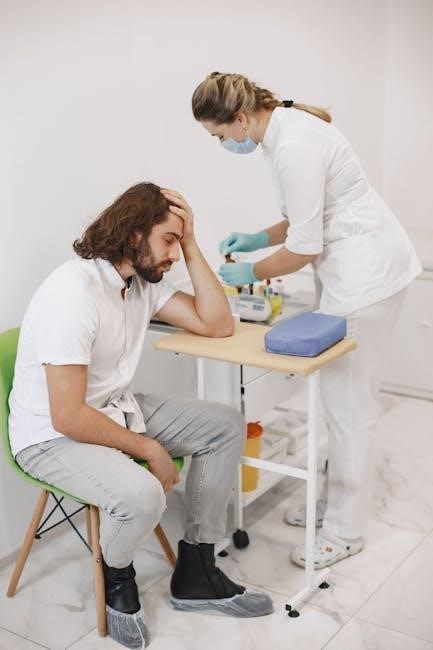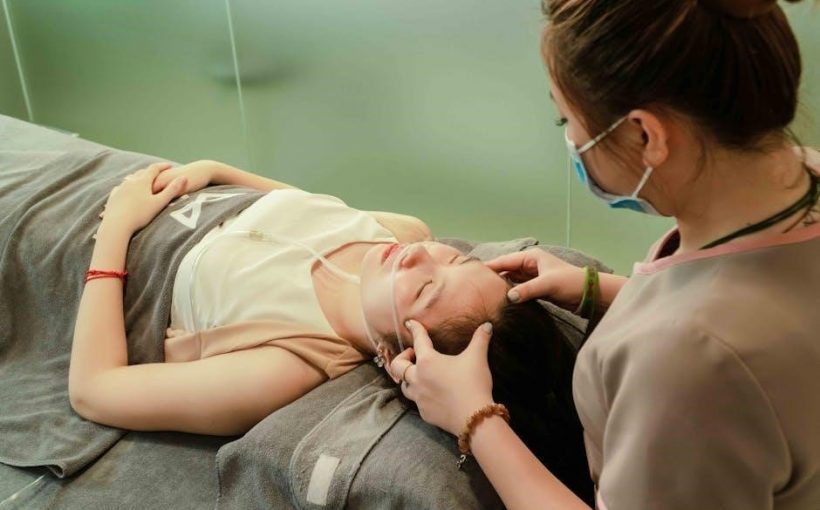A head-to-toe assessment is a systematic evaluation of a patient’s physical condition, from the head to the toes, ensuring early detection of potential health issues and guiding care plans effectively.
Overview of the Head-to-Toe Assessment Process

The head-to-toe assessment is a systematic, organized approach to evaluating a patient’s physical condition, starting from the head and progressing downward to the toes. This method ensures a thorough examination of all body systems, including the neurological, cardiovascular, respiratory, gastrointestinal, musculoskeletal, and genitourinary systems. The process begins with observing general appearance, vital signs, and mental status, followed by inspecting and palpating specific areas. Nurses use tools like stethoscopes and blood pressure cuffs to gather accurate data. The assessment also includes evaluating pain, mobility, and skin integrity, with special attention to areas prone to pressure ulcers or toenail disorders. Documentation of findings is critical, as it guides care plans and communication among healthcare teams, ensuring comprehensive and patient-centered care.

The Importance of Systematic Approach in Nursing Assessment
A systematic approach in nursing ensures thoroughness, enhances accuracy, and improves patient comfort. It helps in early detection of issues and guides effective care planning.
Pain Assessment and Its Role in Head-to-Toe Evaluation
Pain assessment is a critical component of the head-to-toe evaluation, as it directly impacts patient outcomes and care planning. Nurses use standardized tools, such as the FLACC scale for preverbal patients, to evaluate pain intensity and characteristics. Accurately identifying the location, quality, and severity of pain helps guide interventions and improve comfort. Pain assessment also aids in detecting underlying conditions early, ensuring timely and effective management. By systematically incorporating pain evaluation into the head-to-toe process, nurses can address patient needs comprehensively, enhancing overall care quality and patient satisfaction. This step ensures that pain is not overlooked, making it a vital part of the assessment process.

Key Components of a Comprehensive Head-to-Toe Assessment
A comprehensive head-to-toe assessment includes evaluating vital signs, general appearance, ABCDEs (Airway, Breathing, Circulation, Disability, Exposure), and documenting findings systematically to guide patient care effectively.

Evaluation of Vital Signs and General Appearance
Evaluation of vital signs (temperature, pulse, respiratory rate, blood pressure, and oxygen saturation) provides baseline data on a patient’s physiological state. General appearance assessment includes observing posture, facial expressions, and grooming to identify potential health issues. Changes in vital signs, such as elevated temperature or irregular pulse, may indicate underlying conditions like infection or cardiac dysfunction. Observing skin color, moisture, and turgor helps detect hydration status or circulatory issues. Abnormal findings, such as pallor or cyanosis, warrant further investigation. This step lays the foundation for a thorough head-to-toe assessment, enabling nurses to prioritize care and address abnormalities promptly. Accurate documentation ensures continuity of care and informs individualized patient interventions.
Assessment of the ABCDEs (Airway, Breathing, Circulation, Disability, Exposure)
The ABCDE assessment is a prioritized approach to evaluate a patient’s physiological stability. It begins with ensuring a patent airway, Checking for obstructions and respiratory effort. Next, breathing is assessed through inspection, auscultation, and percussion to identify abnormalities like wheezes or crackles. Circulation involves evaluating heart rate, rhythm, and peripheral pulses, as well as capillary refill to detect shock or cardiac issues. Disability focuses on neurological status, using the AVPU scale and Glasgow Coma Scale to assess consciousness and motor function. Finally, exposure involves examining the body for signs of injury or illness, such as bruises, rashes, or deformities. This systematic approach ensures critical issues are identified and addressed promptly, guiding immediate care and interventions. It is a cornerstone of emergency and trauma nursing assessments.

Cardiovascular and Respiratory System Evaluation
The cardiovascular and respiratory assessment involves inspecting and palpating the chest, auscultating heart and lung sounds, and evaluating rate, rhythm, and effort to detect abnormalities like murmurs or wheezes.
Inspection and Palpation of the Heart and Lungs
During the heart and lung assessment, nurses start with inspection, observing the chest for symmetry and breathing patterns. Palpation involves feeling the chest for vibrations or tenderness. Auscultation follows, listening to heart sounds (S1, S2) and lung sounds (vesicular, bronchial) with a stethoscope. Abnormal findings may include murmurs, gallops, wheezes, or crackles, which indicate potential issues like heart failure or respiratory distress. Proper technique ensures accurate findings, guiding further diagnostics and interventions. This systematic approach is crucial for identifying cardiovascular and respiratory abnormalities early, ensuring timely and effective patient care.
Neurological and Musculoskeletal Assessment
This assessment evaluates the patient’s cranial nerves, motor function, and muscle strength. Nurses inspect for signs of atrophy or tremors and palpate for tenderness or abnormalities, ensuring comprehensive neurological and musculoskeletal evaluation.
Evaluation of Cranial Nerves and Motor Function
Evaluation of cranial nerves involves assessing their sensory and motor functions, such as olfaction, vision, hearing, and facial movements. Nurses test cranial nerves I through XII, ensuring proper function of sensory and motor pathways. Motor function assessment includes evaluating muscle strength, tone, and coordination. Nurses observe for tremors, atrophy, or fasciculations, which may indicate neurological deficits. Reflexes, including deep tendon reflexes, are also tested to assess the integrity of the central and peripheral nervous systems. This systematic approach helps identify abnormalities, enabling early intervention and personalized care plans. Documentation of findings is critical for tracking progress and communicating with the healthcare team.

Skin Integrity and Genitourinary Assessment
Skin integrity involves inspecting for pressure ulcers, wounds, or infections. The genitourinary assessment evaluates for signs of infection, incontinence, or other abnormalities, ensuring holistic patient care and proper documentation.
Identification of Pressure Ulcers and Toenail Disorders
Pressure ulcers are assessed for staging, with stages ranging from intact skin to deep tissue damage; Nurses inspect areas prone to pressure sores, such as the sacrum and heels, documenting any signs of redness, swelling, or open wounds. Toenail disorders, including ingrown nails or thickening, are also evaluated to prevent complications. Proper documentation and early intervention are crucial for effective wound care and patient comfort, ensuring timely treatment and minimizing the risk of infection or further tissue damage.
Documentation and Communication in Head-to-Toe Assessment
Accurate and timely documentation is critical in head-to-toe assessments, ensuring continuity of care and legal accountability. Nurses record findings systematically, noting abnormalities and changes from baseline. Clear communication of assessment results to healthcare teams prevents errors and enhances patient safety. Standardized tools and formats, such as SBAR (Situation, Background, Assessment, Recommendation), facilitate effective reporting. Documentation also serves as a reference for tracking progress and informing future care plans. By maintaining thorough and precise records, nurses ensure that patient needs are addressed comprehensively, promoting high-quality care and better health outcomes.
